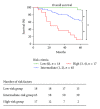Serum N-glycan profiling predicts prognosis in patients undergoing hemodialysis
- PMID: 24453820
- PMCID: PMC3884780
- DOI: 10.1155/2013/268407
Serum N-glycan profiling predicts prognosis in patients undergoing hemodialysis
Abstract
Background: The aim of this study is to evaluate the usefulness of serum N-glycan profiling for prognosis in hemodialysis patients.
Methods: Serum N-glycan analysis was performed in 100 hemodialysis patients in June 2008 using the glycoblotting method, which allows high-throughput, comprehensive, and quantitative N-glycan analysis. All patients were longitudinally followed up for 5 years. To evaluate the independent predictors for prognosis, patients' background, blood biochemistry, and N-glycans intensity were analyzed using Cox regression multivariate analysis. Selected N-glycans and independent factors were evaluated using the log-rank test with the Kaplan-Meier method to identify the predictive indicators for prognosis. Each patient was categorized according to the number of risk factors to evaluate the predictive potential of the risk criteria for prognosis.
Results: In total, 56 N-glycan types were identified in the hemodialysis patients. Cox regression multivariate analysis showed cardiovascular events, body mass index, maximum intima media thickness, and the serum N-glycan intensity of peak number 49 were predictive indicators for overall survival. Risk classification according to the number of independent risk factors revealed significantly poor survival by increasing the number of risk factors.
Conclusions: Serum N-glycan profiling may have a potential to predict prognosis in patients undergoing hemodialysis.
Figures






Similar articles
-
Clinical implications of serum N-glycan profiling as a diagnostic and prognostic biomarker in germ-cell tumors.Cancer Med. 2017 Apr;6(4):739-748. doi: 10.1002/cam4.1035. Epub 2017 Mar 20. Cancer Med. 2017. PMID: 28317343 Free PMC article.
-
Serum N-glycan alteration associated with renal cell carcinoma detected by high throughput glycan analysis.J Urol. 2014 Mar;191(3):805-13. doi: 10.1016/j.juro.2013.10.052. Epub 2013 Oct 16. J Urol. 2014. PMID: 24140550
-
Sleep-disordered breathing predicts cardiovascular events and mortality in hemodialysis patients.Nephrol Dial Transplant. 2011 Jul;26(7):2289-95. doi: 10.1093/ndt/gfq756. Epub 2011 Jan 10. Nephrol Dial Transplant. 2011. PMID: 21220756
-
Prolactin levels, endothelial dysfunction, and the risk of cardiovascular events and mortality in patients with CKD.Clin J Am Soc Nephrol. 2012 Feb;7(2):207-15. doi: 10.2215/CJN.06840711. Epub 2011 Dec 22. Clin J Am Soc Nephrol. 2012. PMID: 22193237 Free PMC article.
-
Glycosphingolipid-glycan analysis of human whole serum/plasma based on an endoglycoceramidase digestion.2021 Sep 29 [updated 2022 Mar 22]. In: Nishihara S, Angata K, Aoki-Kinoshita KF, Hirabayashi J, editors. Glycoscience Protocols (GlycoPODv2) [Internet]. Saitama (JP): Japan Consortium for Glycobiology and Glycotechnology; 2021–. 2021 Sep 29 [updated 2022 Mar 22]. In: Nishihara S, Angata K, Aoki-Kinoshita KF, Hirabayashi J, editors. Glycoscience Protocols (GlycoPODv2) [Internet]. Saitama (JP): Japan Consortium for Glycobiology and Glycotechnology; 2021–. PMID: 37590617 Free Books & Documents. Review. No abstract available.
Cited by
-
Clinical implications of serum N-glycan profiling as a diagnostic and prognostic biomarker in germ-cell tumors.Cancer Med. 2017 Apr;6(4):739-748. doi: 10.1002/cam4.1035. Epub 2017 Mar 20. Cancer Med. 2017. PMID: 28317343 Free PMC article.
-
Plasma High-Mannose and Complex/Hybrid N-Glycans Are Associated with Hypercholesterolemia in Humans and Rabbits.PLoS One. 2016 Mar 21;11(3):e0146982. doi: 10.1371/journal.pone.0146982. eCollection 2016. PLoS One. 2016. PMID: 26999365 Free PMC article.
-
Exploring serum and immunoglobulin G N-glycome as diagnostic biomarkers for early detection of breast cancer in Ethiopian women.BMC Cancer. 2019 Jun 17;19(1):588. doi: 10.1186/s12885-019-5817-8. BMC Cancer. 2019. PMID: 31208374 Free PMC article.
-
Aberrant N-Glycosylation Profile of Serum Immunoglobulins is a Diagnostic Biomarker of Urothelial Carcinomas.Int J Mol Sci. 2017 Dec 6;18(12):2632. doi: 10.3390/ijms18122632. Int J Mol Sci. 2017. PMID: 29210993 Free PMC article.
-
Serum N-glycan profiling can predict biopsy-proven graft rejection after living kidney transplantation.Clin Exp Nephrol. 2020 Feb;24(2):174-184. doi: 10.1007/s10157-019-01820-8. Epub 2019 Nov 25. Clin Exp Nephrol. 2020. PMID: 31768865
References
-
- Levey AS, Beto JA, Coronado BE, et al. Controlling the epidemic of cardiovascular disease in chronic renal disease: What do we know? What do we need to learn? Where do we go from here? American Journal of Kidney Diseases. 1998;32(5):853–906. - PubMed
-
- Sarnak MJ, Levey AS, Schoolwerth AC, et al. Kidney disease as a risk factor for development of cardiovascular disease: a statement from the American Heart Association Councils on Kidney in Cardiovascular Disease, High Blood Pressure Research. Hypertension. 2003;42(5):1050–1065. - PubMed
-
- Foley RN, Parfrey PS, Sarnak MJ. Clinical epidemiology of cardiovascular disease in chronic renal disease. American Journal of Kidney Diseases. 1998;32(5):S112–S119. - PubMed
-
- Stam F, Van Guldener C, Decker A, et al. Endothelial dysfunction contributes to renal function-associated cardiovascular mortality in a population with mild renal insufficiency: the Hoorn study. Journal of the American Society of Nephrology. 2006;17(2):537–545. - PubMed
-
- Bostom AG, Shemin D, Verhoef P, et al. Elevated fasting total plasma homocysteine levels and cardiovascular disease outcomes in maintenance dialysis patients: a prospective study. Arteriosclerosis, Thrombosis, and Vascular Biology. 1997;17(11):2554–2558. - PubMed
Publication types
MeSH terms
Substances
LinkOut - more resources
Full Text Sources
Other Literature Sources
Medical

